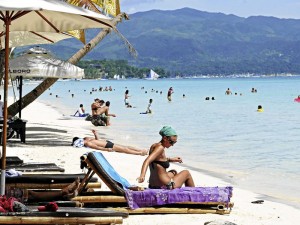
The DOT’s game plan is to match the Philippines’ products with the market’s actual needs. INQUIRER FILE PHOTO
Tourist arrivals breached the 400,000 mark in January, accounting for a 17.5-percent increase from the nearly 350,000 visitors in the country in the same month last year.
Describing the feat as a “historic first for Philippine tourism,” Tourism Secretary Ramon Jimenez Jr. was optimistic that the figure would continue to surge, especially with the launch of the country’s new tourism brand campaign, “It’s More Fun in the Philippines.”
“We are happy to set a new all-time high for the industry, as we have now reached and surpassed the 400,000 visitor arrival mark for the first time in any single month,”Jimenez said in a statement.
Records showed that a total of 411,064 foreign tourists visited the Philippines in January 2012, accounting for a 17.5-percent jump from the 349,713 visitors who came to the country in the same period last year.
Koreans highest number
Koreans accounted for 102,166 visitors, or 24.9 percent of the total.
This was another accomplishment for the country’s tourism since it was also the first time that a market achieved more than 100,000 in a single month, Jimenez noted. In January 2011, 92,249 travelers from Korea visited the country.
The United States is currently the second top source market for tourists, generating 15.4 percent of the total inbound traffic or 63,160 arrivals.
China accounted for the third biggest volume of 42,868 arrivals—more than double than last year’s 15,656 visitors. The tourism agency attributed the heavy influx from the Chinese market to the celebration of the Chinese New Year on the third week of January.
The Japanese and the Taiwanese markets ranked fourth and fifth as top suppliers, with 32,089 and 21,995 arrivals, respectively. Australia, Canada, Hong Kong, Singapore, United Kingdom, Malaysia and Germany also posted as among the major source of tourist arrivals for January this year.
Convergence initiatives
“We expect that these numbers will continue to steadily increase with the introduction of our new brand campaign this year and the convergence initiatives and efforts that the Department of Tourism (DOT) has been undertaking with other government agencies and the private sector,” Jimenez added.
The European Chamber of Commerce in the Philippines (ECCP) however is not so upbeat following a series of setbacks in the country’s aviation industry.
The most recent blow was Air France/KLM’s decision to halt direct flights between Amsterdam and Manila starting this week, citing burdensome and discriminatory taxes. Instead, the company said it would have its Manila-Amsterdam service via Taipei.
“The problem with Air France is just a small part of a larger problem for the airline industry in the Philippines,” ECCP executive vice president Henry Schumacher said in an interview Tuesday.
“The target of 10 million tourists by 2016 is a tall order,” Schumacher said. Last year, 4 million tourists visited the Philippines.
Last flight to Europe
Air France/KLM said its main reasons for stopping direct flights to Manila were the 3-percent common carriers tax (CCT) and 2.5-percent gross Philippine billings (GBP) tax charged on foreign airlines flying to the Philippines.
“Both these taxes have a significant impact on our financial performance on our line to Manila,” Air France/KLM country manager to the Philippines Cees Ursem said.
Air France/KLM’s Manila to Amsterdam flights were the Philippines last remaining direct link to Europe.
Moves to scrap taxes
In an e-mail to the Philippine Daily Inquirer, Ursem pointed out that the effects of the additional taxes had forced other European carriers to stop all their services to the Philippines altogether.
Because both the CCT and the GBP are percentage taxes, airlines have to pay higher if flights are longer. “This impact has made the other European carriers suspend their operations to the Philippines. The long-haul carriers are worst-affected by these taxes,” Ursem said.
Proposals to remove the taxes on foreign airlines are already pending in both houses of Congress.
In a report last month, the International Air Transport Association said the removal of the CCT and GBP would create thousands of new jobs and lead to as much as $78 million (P3.3 billion) in additional revenues annually from increased tourist arrivals.
“If both taxes are removed then we will reconsider the direct operations to the Philippines in the near future,” Ursem said.
Schumacher said other reforms were still needed if the country was to attract more airlines, and, in effect, more tourists.
PH on US, EU blacklist
He said the country’s standing with the US Federal Aviation Administration (FAA) and the European Union (EU), which both put the Philippines on their respective blacklists, should also be addressed soon.
The FAA’s “Category 2” status for the country means all Philippine carriers are barred from expanding operations to the United States. The country was downgraded in 2007 due mainly to significant lapses in its aviation regulatory regime.
The European Union has a similar ban on the Philippines, barring all airlines from even entering European airspace.
Originally posted: 6:49 pm | Tuesday, March 27th, 2012

